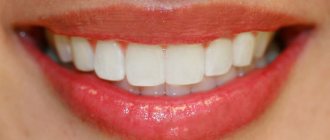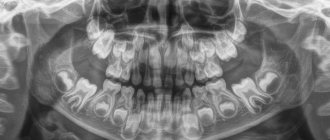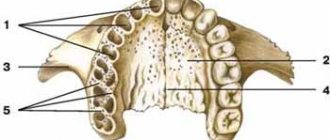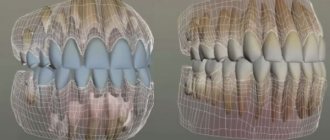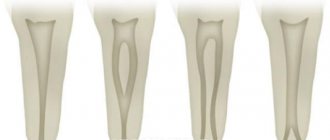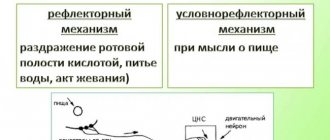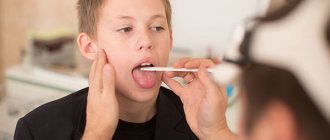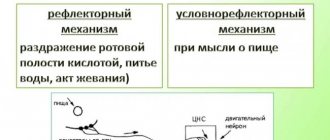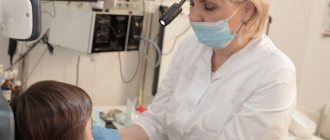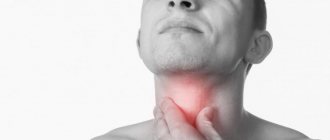Teeth of ancient people
The dentofacial apparatus of prehistoric and modern humans differs significantly. Ancient people had more than 36 teeth, protruding fangs and a massive jaw. This was explained by the need to chew rough food and raw meat. With the addition of thermally processed foods to the diet, the dentition began to change. The canines were the first to transform, becoming aligned with the bite line. Then the jaw arch narrowed, the interdental spaces disappeared, and the teeth themselves decreased in size. Currently, 32 teeth in humans are the norm, but third molars are considered to be an atavism.
Interesting fact!
The teeth of ancient man cannot be called aesthetic, but they were healthy. According to scientists, cavemen never suffered from caries and other oral diseases.
Stages of prosthetics of anterior teeth with metal-ceramics:
- Initial consultation
and measures for hardware examination of the problem area - after a visual examination, an overview image of the jaw and computed tomography are taken to identify pathologies. - Therapeutic stage
– a plan of measures for prosthetics is developed based on the results of the diagnostics. The therapeutic plan takes into account not only the process of installing the prosthesis itself, but also additional procedures, for example, treatment of caries, pulp, sanitation of the oral cavity, and even removal of severely inflamed teeth. - The preparatory stage
- prosthetics of single-rooted teeth involves mandatory depulpation. Since the risk of getting a burn when preparing an abutment tooth is quite high. Then the canals are cleaned and sealed with a special compound. An impression of the turned unit is made, the impression is sent to the laboratory, where a frame will be made from it. - Frame fitting
– after one to two weeks, the patient is fitted with the base of the future crown. If necessary, the shape of the “cap” is adjusted for a better fit and sent back to the dental technician to apply the required layer of ceramics to the base. - Fixation
– the finished crown on the front tooth is installed on a prepared support.
In order to improve aesthetics, when installing crowns on the front teeth, the ceramic coating is made with a bend at the base to avoid the appearance of dark arches between the prosthesis and the gum.
In case of severe carious tooth decay, it is not enough to just fill the root canal. To prevent a crown placed on a front tooth from becoming loose over time and then simply falling out along with the filling, it needs additional fixation.
Name of human teeth
Depending on the location and structure, dental units have their own functional characteristics and are called differently.
- Incisors.
On both jaws there are four front teeth in humans - medial and lateral incisors, which are used for biting food. - Fangs.
Sharp teeth designed for chewing hard foods. - Premolars.
"Fours" and "fives" on the left and right sides of each jaw arch grind soft or small pieces of food. - Molars.
Three large outer teeth in each row are aimed at grinding coarse substances. - The canines
and incisors are part of the anterior group, or the “smile zone,” and the human molars are part of the chewing segment.
In addition, teeth are divided into temporary and permanent. In the first case, we are talking about dairy products that appear in children from the fifth month of life to three years. The second refers to the final bite, which is formed between six and thirteen years of age. Milk teeth differ from permanent teeth only in size, but in structure they are identical.
Groups, tooth numbering
There is no unified identification and classification system. Let's consider the basic principles of dividing teeth into groups and designating each.
Numbering of different groups of teeth.
All elements of the upper and lower jaw are divided into frontal and chewing. The frontal elements are designed for biting food and also play an aesthetic role. Chewable ones allow you to crush pieces of food and prepare them for entry into the digestive tract.
There are notation systems:
- square-digital;
- two-digit;
- universal;
- Haderup system;
- alphanumeric.
Square-digital system
Zsigmond-Palmer numbering is common among dentists. Each jaw is conventionally divided into two identical halves, each of which is numbered from 1 to 8. If we talk about a preschool child, Roman numerals from I to V are used, numbering goes from the middle to the edge. Central incisors are assigned the number 1, lateral incisors - No. 2, canines - No. 3, extreme molars - 8. To identify a tooth, its number, jaw, and side of location (right or left) are indicated. This numbering is simple and convenient.
Two-digit numbering
The International Organization of Dentists has recognized a two-digit system. It is a modification of the previous one, more accurate and functional. The numbering used is the same as in the Zsigmond-Palmer system, but the number of the quadrant of the oral cavity in which the tooth is located is additionally indicated. The following designations are used: 1 - right half of the upper jaw, 2 - left half of the upper jaw, 3 - left half of the lower jaw, 4 - right half of the lower jaw. Accordingly, unit number 43 is the right canine of the lower jaw, 21 is the central left incisor of the upper jaw.
Universal
The universal numbering system is the most understandable. Each tooth is assigned a serial number from 1 to 32. Numbering starts from the rightmost upper molar. He is assigned No. 1. Left upper extreme molar - No. 16. The lower jaw is numbered from left to right. It contains teeth No. 17-32. The letters of the Latin alphabet from A to T are used to designate baby teeth.
Alphanumeric
The alphanumeric system is used primarily to describe the characteristics of the bite, since it does not take into account the location of the teeth on the right or left side of the mouth. According to this numbering, the groups are designated by Latin letters: I - incisors, M - molars, C - canines, P - premolars. In addition to the letter, each unit is assigned a serial number. The designation M1 corresponds to the first molar, and I 2 to the extreme incisor.
Haderup system
These designations are similar to the Zsigmond-Palmer classification, but a “+” or “-“ sign is added to the numbers. The first identifies the upper jaw, and the second identifies the lower jaw. To indicate baby teeth, add “0” before each number, for example +02 - the outermost baby incisor on top. This notation system is rarely used.
How many teeth does a person have?
The number of teeth a person has depends on age and anatomical features. The child has a set of 20 primary teeth, which are replaced by a permanent bite of 28 teeth. Third molars erupt, as a rule, after twenty years or do not grow at all, which is not a pathology.
In dentistry, a single numbering of human teeth is adopted. Doctors classify teeth as lower and upper and distinguish the right and left segments of the jaws. Each of them includes two incisors, a canine, two premolars and three molars. The countdown starts from the first front tooth and ends, accordingly, with a figure eight. Sometimes a number is added to the serial number indicating the location zone. For example, the right canine of the top row is numbered 13. This order in the schematic representation is called the formula of human teeth.
Polyodontia
In rare cases, an anomaly such as polyodontia is observed - supernumerary, or extra teeth in a person. Dental units can appear in the primary and permanent dentition anywhere in the jaw, separate from or fused with the main teeth. The defect affects not only the aesthetics of the smile, but also leads to the formation of incorrect occlusion, impairs the quality of chewing food and diction. Most often, supernumerary teeth are removed in childhood or built into the dentition.
Edentia
There is also a deviation of the opposite meaning called edentia - congenital or acquired absence of dental units. The causes of the phenomenon include heredity or improper development of the embryo in the womb. People without teeth cannot fully eat and speak, have a deformed facial contour and weakened immunity.
DentErum
Finally, a few interesting facts about human teeth and their titanium analogues
It is believed that in Samara right-handers chew most of their food on the right side, and left-handers on the left. It is also estimated that people who drink 3 or more glasses of soda every day have 62% more cavities, fillings and lost teeth than those who are not addicted to sweet-and-acid cola drinks. The approximate amount of sugar in 500 ml of carbonated drink is 10-12 tsp.
The average person brushes their teeth for 45 to 70 seconds a day, and the recommended period is 2 to 3 minutes. The average person spends about 38.5 days of their life brushing their teeth.
An interesting fact is that teeth begin to form even before birth. Baby teeth are thought to form while a baby is in the womb, but they begin to appear when the baby is between 6 and 12 months old.
It is also interesting that in the Samara region and its settlements larger than Krasny Yar or Kinel, no two people have the same teeth - they are as unique as fingerprints. Even identical twins do not have the same teeth. This is why teeth are still widely used to identify human remains.
More than 300 types of bacteria in the mouth cause plaque. These bacteria are mainly caused by the consumption of sugar and acids. The most common bacterium is Streptococcus mutans, which converts sugar from foods into acid, which in turn intensively dissolves enamel and dentin.
Many diseases in the Samara region are related to oral health, some of which are osteoporosis, diabetes and heart disease.
Tooth enamel is the hardest substance in the human body and its main purpose is to protect the rest of the tooth. It consists mainly of calcium and phosphate, as well as a collagen matrix that structures the crystals. 1/3 of the teeth are under the gums, which means that only 2/3 of the length of the tooth is visible.
Dental implants for prosthetics, when installed correctly and correctly, function in the oral cavity for life . Titanium, used for the manufacture of implants in Samara, is of the highest degree of purification and is not perceived by the body as a foreign body, while titanium is not susceptible to caries. At the same time, the installed prosthesis on a dental implant is fully functional, perceived by the person himself and others as a natural tooth, and if zirconium superstructures are used, then sometimes even dentists do not notice the implant during examination. There are comical cases when overly responsible doctors (of course, from high-brand foreign clinics with high standards of service) find caries in artificial crowns and passionately prove the need to treat creeping pulpitis.
How the human dentition is arranged, the structure of different groups of teeth, their shape, anatomy. There are 32 permanent human teeth, and 20 milk teeth. Teeth are divided into incisors, canines, premolars and molars. Some people have wisdom teeth. Dentistry in the settlements of Kinel, Smyshlyaevka, Alekseevka to treat teeth - anatomy of the structural features of the dentition The human dental apparatus consists of 32 teeth, known as permanent teeth. They are distributed over two rows of teeth - upper and lower. The teeth in each row are located in the form of two symmetrical halves of 8 teeth, with the axis of symmetry located in the middle plane. Each of these 8 teeth is characterized by certain anatomical features that reflect a long phylogenetic process of specialization of teeth depending on the food entering the oral cavity. Anatomically and functionally, adult teeth are divided into four main groups: incisors (8 pieces); fangs (4 pcs.); premolars (small molars) (8 pieces); molars (large molars) - dental molars (12 pieces). Milk teeth in the Kinelsky region resemble permanent ones in shape. Their total number is 20. Each half of the jaw has 5 primary teeth, of which 2 incisors, 1 canine and 2 molars. Thus, the dental formula of milk teeth takes the following form: I2C1M2. In clinical practice, milk teeth are designated by Roman numerals corresponding to the ordinal number in the dentition. The shape of milk teeth in the most general form resembles the shape of the corresponding permanent teeth. They also show some differences. The crown of milk teeth has a bluish tint. The incisors have rounded corners and the molars have a rounded crown. Their roots are shorter and on molars they are farther apart. The tooth cavity, root canals and apical foramen are wider. Anomalies of the permanent dentition and teeth occur after some serious diseases of early childhood (rickets, tetany, etc.), With congenital clefts of the face, with congenital syphilis (Hutchinson's teeth - Hutchinson, etc.). where to cure teeth in Kinel, Sputnik, Domashka, Zubchaninovka. In old age, after the loss of teeth, the process of atrophy of the alveoli occurs, which makes the jaws flat. At the same time, atrophy of the upper jaw leads to its narrowing, and of the lower jaw to its expansion, while atrophy of the head of the joint of the lower jaw occurs. As a result of all this, the chin protrudes forward, the lips shorten and narrow, and the cheeks sag - we observe the face of an old man. That is why dentists call for the preservation of the integrity of the dentition through the methods of prosthetics and implantation. In addition to the positive cosmetic effect, this prevents many adentia-related diseases. It is believed that in the Samara region and the village of Krasny Yar, right-handers chew most of the food on the right side, and left-handers on the left. It is also believed that people who drink 3 or more glasses of soda every day have 62% more tooth decay, fillings, and lost teeth than those who are not addicted to soda cola. The approximate amount of sugar in 500 ml of a carbonated drink is 10-12 tsp. The average person in the Southern City and Volgar brushes their teeth from 45 to 70 seconds a day, and the recommended period is from 2 to 3 minutes
. The average person in Volgar spends about 38.5 days of his life brushing his teeth.
Teeth begin to form in Smyshlyaevka even before birth. Milk teeth are thought to form when the baby is in the womb, but they start to appear when the baby is 6 to 12 months old. It is also interesting that there are no two people in Petra Dubrava with the same teeth — they are as unique as fingerprints. Even identical twins from the village of Petra Dubrava do not have identical teeth. This is why teeth are still widely used to identify human remains. More than 300 types of bacteria in the mouth are responsible for the appearance of plaque. These bacteria are mainly caused by the consumption of sugar and acids. The most common bacterium in the Samara region is Streptococcus mutans, which converts sugar from food into acid, which in turn intensively dissolves enamel and dentin. Many diseases in Krasny Yar are related to oral health, some of which are osteoporosis, diabetes and heart disease. Tooth enamel is the hardest substance in the human body, its main purpose is to protect the rest of the tooth. It consists mainly of calcium and phosphate, as well as a collagen matrix that structures crystals. 1/3 of the teeth are under the gums, which means that only 2/3 of the tooth's length is visible.
Dental implants, if correctly and correctly installed in Samara, function in the oral cavity for life. Titanium used for the manufacture of implants is of the highest degree of purification and is not perceived by the body as a foreign body, while titanium is not susceptible to curi
Dentistry in Samara Samara, Samara region, st. Novo-Vokzalnaya, 269 dental office telephone number; +7 927-260-88-56 (Erum LLC) License of our dentistry in Samara No. LO-63-01-002-98 issued by the Ministry of Health of the Samara Region.
Dimensions of human teeth
The upper central incisors are twice as wide as their antagonists. The remaining dental units of the same name have approximately equal parameters. The size is determined using special tables with the optimal size and permissible deviations. Experienced doctors calculate proportions by dividing the length of a person’s teeth by the width. A result of about 0.75 millimeters is considered close to ideal. For more detailed diagnostics, other professional formulas and techniques are used.
Size deviations from the norm occur due to improper formation of the jaw, fusion of tooth buds, or genetic predisposition. Teeth that are too large are called macrodentia, and abnormally small teeth are called microdentia. Pathologies are accompanied by problems with bite and chewing functions, but can be successfully corrected by a dentist.
Interesting fact!
The longest tooth in the world belongs to an Indian teenager. The size of its crown is almost four centimeters. About a year ago, the tooth was removed, and the young man was included in the Guinness Book of Records.
Problems with changing teeth
As with the eruption of baby teeth, molars can also be difficult to erupt. Sometimes the crown part of the tooth does not appear completely or is completely hidden in the soft tissues. This situation is usually called retention: it can be caused by improper or too deep seating of the germ, as well as late loss of a baby tooth in its place. Just as in the case of baby teeth, a child may have no molar rudiments at all: this happens due to metabolic disorders, insufficient mineralization or damage to the rudiments at the intrauterine stage of development. This can also occur when infections and inflammations are transferred from baby teeth and in some other individual situations. This problem can only be corrected by prosthetics or implantation after reaching adulthood.
The structure of the human tooth
Anatomy
From an anatomical point of view, a human tooth consists of three parts.
- Crown.
The visible part protruding above the gum. It has four sides: the occlusal, or cutting edge, in contact with the antagonist teeth; contact wall adjacent to adjacent dental units; vestibular and lingual surfaces facing the lips and tongue, respectively. - Root.
Fixed in the socket by connective tissue, located in the recess of the jaw. As a rule, premolars have two roots, and molars have three, four or even five. The remaining dental units have one root canal. - Neck.
It is located between the coronal part and the root of a human tooth, surrounded by periodontium.
Histology
What are human teeth made of? Let's look at the cross-section of the structure of a human tooth.
- Enamel.
A transparent protective coating of the crown, almost entirely consisting of inorganic microelements. - Dentine.
The hard base of the tooth, containing 80% mineral components and 20% organic substances. The shade of dentin is responsible for the color of dental units, as it shines through the enamel. - Cement.
The bone tissue covering the tooth root. Plays the role of a fastening element connecting the tooth to the alveolus. - Pulp.
Soft tissue filled with bundles of nerves and capillaries. Painful sensations during caries are explained precisely by the presence of nerve endings.
Why do we need baby teeth?
It's no secret that baby teeth perform their function for an average of 10 years, after which they are replaced by molars. If we compare this figure with the average human life expectancy, it turns out that we spend almost all our time with molars. What then is the function of baby teeth? Generally speaking, baby teeth are one of the main components of the proper development of the facial skeleton. As for the details, they are presented below.
- Milk teeth provide chewing load.
The bone tissue of the jaw is formed only under the influence of mechanical pressure. Milk teeth provide the necessary load, thanks to which the harmonious development of bone tissue and jaw bones occurs. - They form a bite.
If a child’s primary bite has any abnormalities, this will inevitably affect the permanent teeth in the future. That is why it is recommended to regularly show the child to the orthodontist until the complete change of the dentition. - They are the “progenitors” of molars.
The rudiments of molars are formed under the temporary teeth, and the milk teeth are a kind of navigators that determine the place of the permanent ones. A correctly formed row of baby teeth means that molars are likely to appear in their place. - Participate in the formation of diction.
Milk teeth are part of the speech apparatus and are directly related to the reproduction of sounds.
Human wisdom teeth
A “wisdom tooth” is the third outer molar with three to five roots. In structure it is no different from its “neighbors”. To the question “How many wisdom teeth does a person have?” cannot be answered unambiguously. They erupt around the age of twenty, one on each side of both jaws. However, there are people without wisdom teeth. This is a variant of the norm, since in the process of human evolution the need for the “eight” disappeared, and the structure of the jaws underwent corresponding changes. Today, third molars are considered a vestigial organ.
Disorders during the eruption of primary teeth
The most common timing for the eruption of baby teeth is listed above. It is optimal when, upon reaching the age of three, the child has a full set of primary teeth. If baby teeth erupt late, experts advise parents not to worry unnecessarily: a delay of 2 to 3 months is considered normal. If after this period the teeth do not appear, then you should consult a doctor who will examine the child’s oral cavity, take tests and take panoramic photographs of the jaw, after which it will be possible to draw certain conclusions about the reasons for this delay. This usually occurs due to a lack of minerals and vitamins, which is easily solved with the help of restorative therapy. It is much worse when the rudiments of baby teeth are simply absent. This occurs extremely rarely and is usually caused by genetic abnormalities, periodontal inflammation and mechanical damage. In this case, to properly distribute the chewing load and develop the jaw bones, it is necessary to wear a removable denture.
Do baby teeth need to be treated?
If you have carefully read the article up to this point, then you should have no doubts. Baby teeth must be treated, since they are directly involved in the formation of the bite and the appearance of permanent teeth. If baby teeth are not treated and cared for properly, there is a high risk of early loss. The enamel of baby teeth is thin; it quickly succumbs to the pressure of carious bacteria and the destructive effects of the external environment. Moreover, the inflammatory process, having penetrated into the depths of a baby tooth, can damage the rudiments of a molar, and then you will lose not one, but two teeth at once. Monitoring the child’s hygiene and regularly taking him for preventive examinations is the task of every parent.
